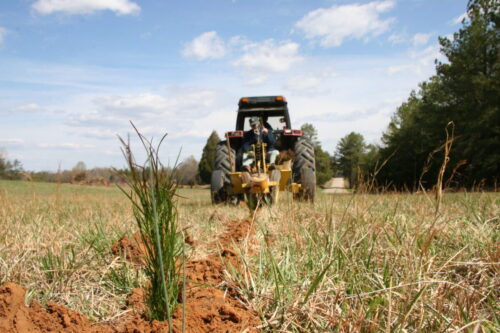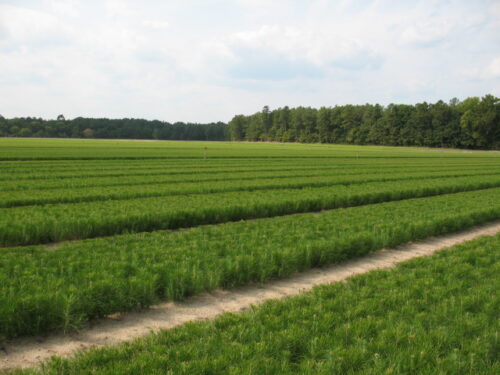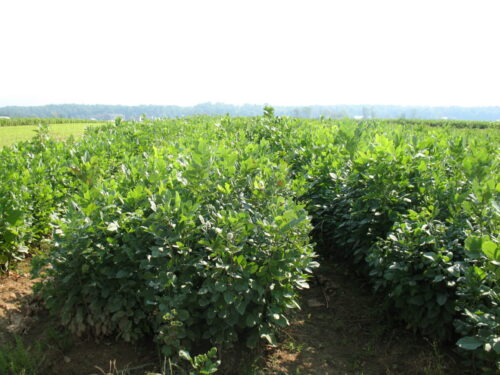Wake Up, Seedlings!
March 14, 2022 2:39 pm

By Todd Groh, DOF Forest Resource Management Program Manager
Can you feel it? The temperatures are rising and the daylight is lingering. New life is pushing up through the once cold soils, and we’re seeing the yellow blooms of daffodils across the Commonwealth. Spring is almost here, and the trees know it too. Red maples are often the first trees to wake up in Virginia forests and along roadways, their buds swelling and tiny flowers bursting brilliant red.

Red maple flowers
In the fall, trees work hard to store all of the energy they’ll need to survive winter in their roots, so they’ll be able to grow new leaves in the springtime. During the colder and darker winter months, most trees, shrubs, vines, and grasses in Virginia go to sleep – or “dormant,” as foresters say. Just as farmers know that early spring is the time to plant seeds for future crops, foresters know that spring is the time to plant pine and hardwood tree seedlings. We typically plant dormant tree seedlings, which have abundant stored energy to begin growing as soon as the temperatures and sunlight conditions wake them up. This natural process is how the Department of Forestry grows millions of high-quality pine and hardwood seedlings each year, to be planted where mature forests have been harvested or in open areas where trees are needed.
Again, much like a farmer, tree nursery managers plant tree seeds in the spring and grow the trees all summer long. But instead of harvesting the trees in the fall, the managers wait for the seedlings to go dormant in the cold and wet winter months. Then, in February and March, the tree seedlings are lifted, roots and all, from the nursery beds, prepared, and shipped all across Virginia. They will “wake up” in a new place, ready to produce leaves and grow more roots in their new home.
- Pines in nursery
- Hardwoods in nursery
It should be noted that containerized trees, like the ones you might buy at garden centers, are best planted in the fall, to maximize time for root growth during the cool season. These trees are larger than the bare-root seedlings used for reforesting large areas. We mainly do large-scale seedling plantings in the spring because there is less chance to damage or “stress” a seedling when it is dormant than when it is actively growing. However, even dormant trees can be damaged; experience has shown us that pine trees seem to handle the lifting and planting stress better than hardwood trees and, often survive better in the new location.
- Hand-planting pine
- Machine-planting pine
The type or variety of tree seedling that is planted and where it is planted depends on many things. The two main considerations are the tree’s specific needs – soil, moisture, and light levels – followed closely by the goals and objectives of the landowner. Most trees are pretty resilient and can survive for a while under many conditions. However, if you want the trees to live and grow well for a long time, you need to match the right tree to the right site. For example, some trees are considered “pioneer species.” They need full sunlight and can grow very fast to stay above the other competing vegetation, but they may not live as long as other trees. Many pine trees that grow in Virginia fit this description. Other trees are “climax species” that can grow in partial sunlight for most of their life, growing more slowly, but living longer than most pioneer trees. So, when the pioneer trees die and fall, the climax trees will take over the forest and live much longer. Many of Virginia’s hardwood trees are considered climax tree species. Whereas most pines are old at age 100, many hardwoods can live for 200 years or more.

Pioneer pines
Landowner goals and objectives are also important considerations when deciding what to plant. If a landowner wants to harvest the trees in their lifetime, they may consider planting pioneer species that can produce a valuable tree in 30-40 years. But a landowner who wants to promote forest benefits rather than a quicker harvest may want to opt for climax trees, which may not produce a valuable tree for 80-90 years.
Professional foresters have studied trees and learned what they need to thrive. Speaking and working with a forester can help landowners make the right tree selection and management decisions. If you’re ready to plant seedlings on your land, you can order some from the DOF nurseries. But do it soon – popular species go quickly!
Tags: Hardwood, Pine, Tree Planting
Category: Forest Management, Nurseries



